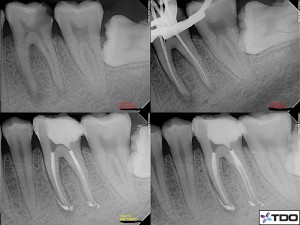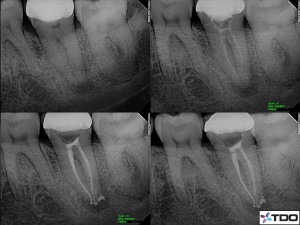I think a few factors can explain why this antiquated mode of restorative care persists on such a widespread basis:
- It is easier to maintain the status quo(or inertia in action, or inaction for that matter!)
- The matter has never been raised by endodontist or referring doctor in any given referral relationship
- Fear of losing a referring doctor
- Unknown restorative situation after assessing the tooth(i.e., will it need a post or not, will it require alternative means of restoration)
- Finances
The following two cases were treated by me in the last few weeks. Both cases were referred from the same practice. The first was restored, at the request of the referring doctor with a provisional restoration. A Class II restoration composed entirely of provisional material is being asked to do a yeoman’s job in preventing leakage. However, because this was requested by the referring doctor, I complied with the request.
As luck would have it, this referring doctor and I had a chance to sit down and discuss the case about a week later. After a brief and pleasant conversation about the issue of leakage, we agreed that at a minimum, an orifice barrier will be placed at the time of obturation for her patients. There may be times when I will restore cases with a post or buildup, but ending cases solely in Cavit is not “best for the patients.”
This same motivation for restorative at the time of obturation was expressed to me by the doctors I referenced at the conclusion of the initial post: “Doing what was best for the patient.” While there will inevitably be times that we have differences in opinion, let the well being of our patients be our guide. As long as we adhere to this, we cannot go wrong. I feel fortunate to work with so many professionals who believe and practice in accordance with this.
The second case is displayed below. After obturation, orifice barriers were placed. After removal of the crown, a new full coverage restoration will be fabricated.
The hardest thing to do is change the status quo.

